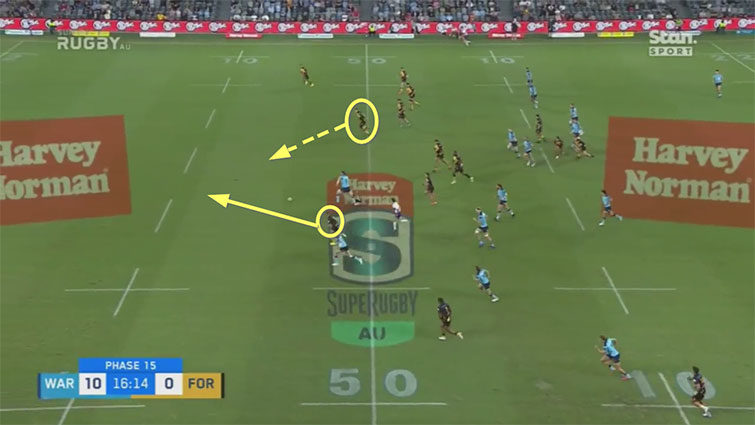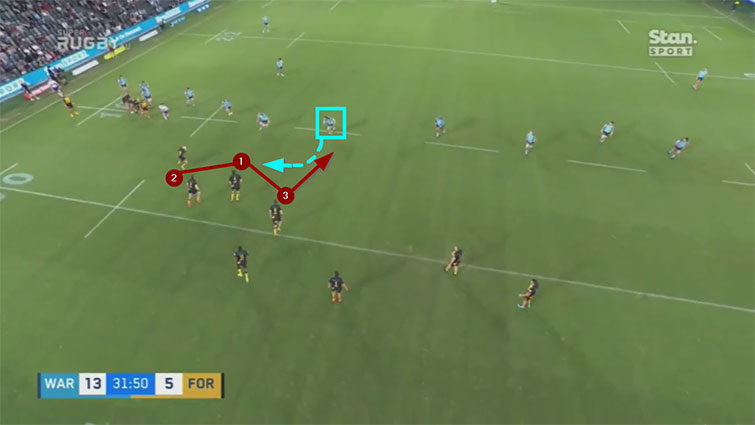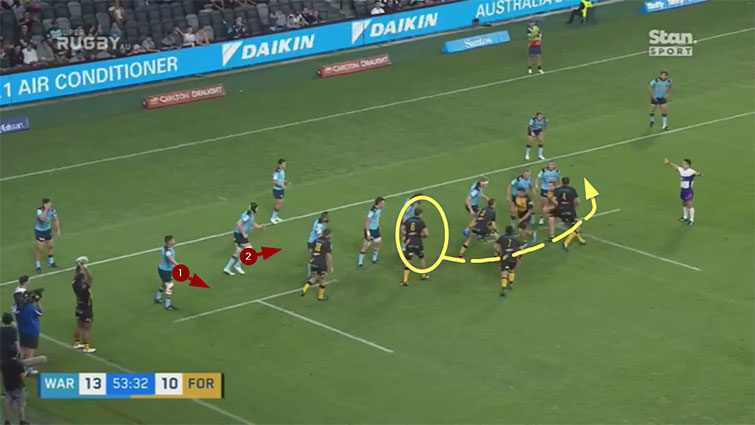Coaches love to tinker. In rugby, they particularly enjoy finding ways to expand the skillset of one position by adding little bits and pieces from another.
Earlier in the season, I explored the ways in which Queensland attack coach Jim McKay uses Hamish Stewart’s background as a schoolboy flanker, in conjunction with his more recent outings at number 10 and number 15, to enrich his current role at number 12 with the Reds.
The modern game is stacked full of players who started life elsewhere, in other sports and positions. League converts like Lote Tuqiri and Wendell Sailor helped redefine the combination of speed, size and skill which was possible on the union wing. 106-cap ex-Waratah prop Sekope Kepu and Scotland rake Stuart McInally played at number eight before moving into the front row.
Most of the shifts aren’t quite as dramatic as that, but you get the picture. Liam Wright improved the Reds by moving his skill-set over to number six to accommodate Fraser McReight in the second half of 2020, and Dave Rennie’s picks on the Wallaby blindside flank last season tended to come from Waratahs with a background in the second row.
One of the more intriguing shifts involves the move from sevens to XVs. In the professional era, sevens is no longer a game which a ‘serious’ fifteens player will use as a light tune-up in the pre-season. It is a game unto itself, and the elite professionals who play it are dedicated single-mindedly to the sport.
The crossovers are as intriguing as those from rugby league. The latest is the Force’s Tim Anstee, who exploded onto the Super Rugby scene by creating one try and scoring another in his side’s ground-breaking win over the Waratahs on Friday evening. He had made a similar splash on debut at the 2017 Sydney Sevens, scoring three tries in as many minutes.
When the 2020 Tokyo Olympics was cancelled, Anstee made the decision to return to his home club Eastwood. He was invited to join the Force at pre-season training by head coach Tim Sampson, and signed a two-year deal with the franchise shortly afterwards.

Tim Anstee. (Photo by Cameron Spencer/Getty Images)
“I knew I would potentially be giving up that Olympic spot but it was a decision I had to make”, he told the Western Australian in January.
“There was a bit too much uncertainty as to whether the Games will go ahead and they are not playing any tournaments at the moment.
“It was the right time and I’m excited about what is happening at the Force.”
Anstee is under no illusions about how hard the transition will be.
“The biggest thing is there is more strategy involved in the fifteens game – lineouts, set-piece and so forth – that you have to get your head around.
“There’s a lot more contact involved. I probably need to put on a few more kilos and get used to that element.
“In sevens, contact is more one-on-one, the work rate is different, you have to be able to pass 15 metres but it’s still rugby union. There’s a few more people on the field, same sort of principles.
“What attracted me is that Tim [Sampson] likes to play that attacking game and to spread the ball wide if it’s on.”
With a lean 103 kilos covering his elongated 1.94-metre frame, Anstee brings sevens attributes to the big show: excellent individual skills, a level of comfort playing in space, and raw speed – lots and lots of raw speed:
How does that translate to the number six position in union? There were some clues on both sides of the ball on Friday evening:
With the Force on attack, Anstee spent most of his evening in the wide right channel, playing in a space where he could utilise his well-honed individual skills. His first instinct after the tackle is pure sevens: release the ball and pick it up again, a common technique when players become isolated in the shorter format.
He also used his speed to excellent effect at a ‘recovery ruck’ in defence:
After a breakdown in the Force attack, the ball is booted through by Waratahs number eight Jack Dempsey, and Anstee’s instincts in space again take over:

Rob Kearney is first to the loose ball, but Anstee is there as the second man in support to stabilise the situation.
The Force scored two memorable tries in the game, both of which pivoted around Tim Anstee’s raw speed and sevens instincts:
When Harry Johnson-Holmes mistimes his jam on to the middle man of the Force three-forward pod, Jeremy Thrush is able to beat him with the speed of the transfer through his hands:

Anstee’s speed through the hole is enough to make the bust, and after that his sevens skills take over. Most blindside flankers confronted by a covering scrumhalf would choose to take contact and deliver the offload if possible.
Not Anstee – he beats him on the outside, and that is enough to drag away the Waratahs’ last remnants of defence and straighten the supporting line to the posts for the eventual try-scorer, Fergus Lee-Warner.
The same two players featured in combination for the Force’s second try, a scripted move from a red-zone lineout:
As I pointed out last year, the policy of defending with the defensive receiver close to the five-metre line at the front can open up space around the tail:

Lachie Swinton is a step slow following the motion of Tim Anstee around the corner, and the Force man scores from a sympathetic pass off the top by Lee-Warner.
While Anstee is an alluring prospect for the Wallaby future in the number six jersey, it is Lee-Warner who is closer to a Test call-up by Dave Rennie in 2021. He has the collective expertise which his teammate is still in the process of acquiring.
Of all the blindside flankers with a second-row background currently plying their trade in Australia, Lee-Warner has shown he has the qualities to succeed at international level.
Aerial expertise? Tick. He has sticky hands and great body control in the air:
The buffeting in the air does not bother Lee-Warner one bit, he only has eyes for the ball or an accurate delivery to his halfback.
Lee-Warner is not only the Force’s top lineout target in 2021 so far, he is the premier forward ball-carrier. While Anstee tops the metres-per-carry metric because of his breaking ability and role out wide in the offensive structure, Lee-Warner has the most carries and most metres after first contact with the tackler.
Productive ball-carrier? Tick.
He does the hards yards carrying one-off from the Force scrumhalf. Approximately 70 per cent of his yardage is earned after the tackle is attempted. In both instances, he finishes by penetrating all the way onto the defensive nine in his sweeping role. That is a good sign.
Powerful, mobile defender? Tick – both in close contact situations, and folding out in space:
In the first example, Lee-Warner has the strength to force back Waratahs second-rower Sam Caird in the contact, and that in turn draws Lachie Swinton around to re-ruck at the base. Slow ball ensues.
In the second, after being beaten in an initial one-on-one with Waratahs number ten Will Harrison at the line, Lee-Warner does not quit on the play. He has the ability to lengthen his stride and haul James Ramm down in cover near the right sideline, forcing the turnover. All this in the 56th minute of the game.
In the third, he shows good discipline in mirroring Nic White on one of those dangerous snipes around the edge of the breakdown, before folding out in cover to strip the ball away from Rob Valetini in the wide right channel.
Summary
Things were looking pretty bleak for Dave Rennie at the number six spot, with Ned Hanigan packing his bags for Japan and Liam Wright picking up an ankle injury in a trial match before the Super Rugby AU season had even started.
But suddenly, there are few encouraging shoots of green growth, and a lot more to life than Lachie Swinton’s return from his four-week ban for a head-high shot on Sam Whitelock.
There are two promising crossovers at the Force riding side-saddle with Rob Valetini’s improvement at the Brumbies. Tim Anstee’s move from the Australian sevens team brings raw speed and a strong individual skillset packed into a physical frame that has considerable room for development.
Meanwhile, Force lock Fergus Lee-Warner may promise the most oven-ready all-round game of the lot, if he can switch successfully to the blindside flank for Rennie. He is a primary lineout target with good hands and body control in the air, he carries the ball effectively in traffic, and he can defend in close and out wide with equal facility. He is not a quitter.
Most of the big sixes with a second-row background selected by the Wallabies in recent seasons (Ned Hanigan, Lukhan Salakaia-Loto and Lachie Swinton) have not been unqualified successes, but Fergus Lee-Warner can change all that in 2021.
The Force may end up celebrating not just a few victories, but their first selection to Dave Rennie’s Wallaby run-on side. Now, would that not be an event worth toasting?
































































































